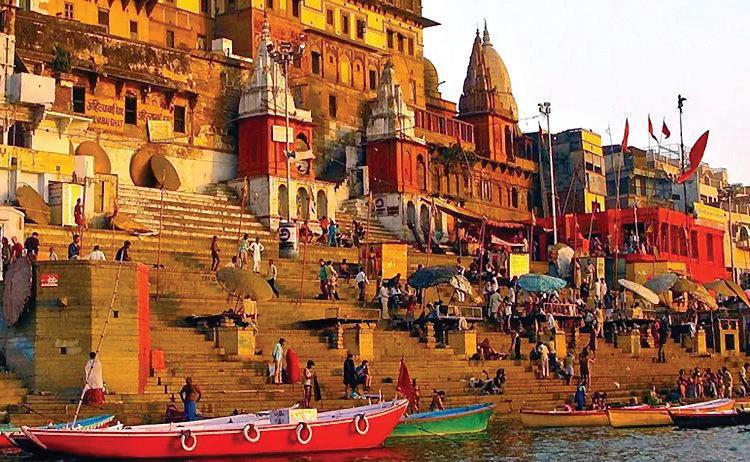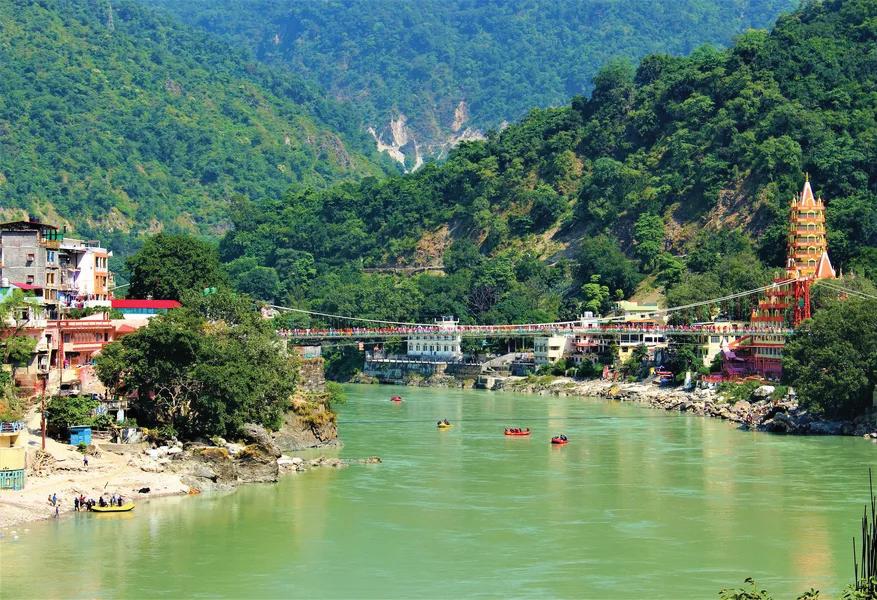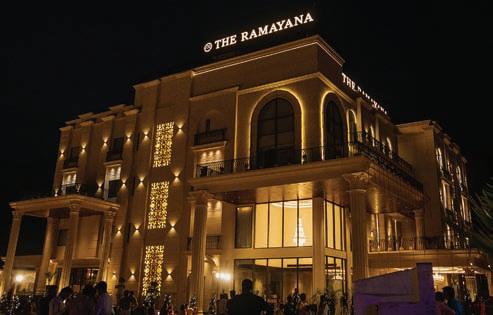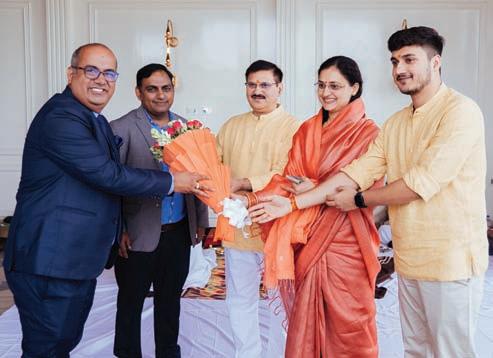
15 minute read
FEATURE
Destinations for the Soul
India is a modern nation with an ancient civilisation. The civilisation of India is still very much living in the hearts and minds of its people, even after its meandering journey through the course of five millennia. With the exception of the Chinese civilisation, perhaps no other great civilisations of the world have experienced such a thread of continuity across several millennia.
Advertisement
And many would agree that religion, coloured with revered hues of mythology, is the cementing factor in the Indian civilisation. India is a diverse land where most major religions of the world, such as Hinduism, Islam, Christianity, Sikhism, Buddhism, Jainism, Zoroastrianism and Judaism are being practiced, and India has places of tourist interest associated with all these religions.
It is no wonder that even in today’s ITpowered India, religion is a source of solace for millions of simple souls, and also a source of money minting for scores of cunning charlatans and so called godmans. Besides these two extremes, religion in India also provides the requisite ambience for savvy business ventures, specially pertaining to the tourism and hospitality sectors.
This enduring influence of religion in our society is misused by cunning charlatans, fake godmen and opportunistic politicians, but the influence of religion in India’s pluralistic socio-cultural environment have immense potential for the Indian tourism and hospitality industry. This potential needs to be tapped in a more proactive, creative and optimal manner.
The Potential
Yes, religion is an important and a steady source of revenue for the tourism industry of India. Religious tourism is not only the largest segment of domestic tourism in India, but it also attracts a sizeable proportion of the inbound crowd every year to its spiritual ambit. Moreover, it is growing at a whooping rate per annum. Religious tourism in India has shown continuous growth. It is because in India, travels for religious reasons are viewed as necessity and not a luxury.
Indian hospitality industry has a huge potential in the area of religious tourism, which is evident from the fact that the demand in this direction keeps increasing year on year. However, most of the travellers love to get end-to-end solutions to their religious trips because of unfamiliarity of places, tourist attractions, conveyance, etc., which eventually becomes the challenging area for this kind of tourism.
The enormous revenue earning potential of religious and cultural tourism in India needs to be more effectively harnessed by the Indian tourism and hospitality industry, and in this regard, our states and the Union Government should play a more proactive role than they are doing at present.
It is common knowledge that India has a plethora of religious sites and shrines to make a devotee of religious tourism explore for a lifetime, at least. From Varanasi to Ajmer to Tirupati and from Gaya to Puri to Rameswaram, the thread of religious tourism in India spreads across the length
and breadth of the country.
From taking a dip at the holy Ganges of Varanasi at the break of the dawn, to feeling the mellifluous music of aarti in your soul as the twilight descends on Hardwar, from undertaking the arduous Amarnath Yatra to standing in the long queue for a darshan of Sri Venkateswara at the Sri Venkateswara Temple, located at Tirupati Hill, from taking a tour of the churches of Goa and feeling the soul of Christianity whose resonance could be heard much beyond the roar of the waves, to praying with a heart full of devotion at the Dargah of Hazrat Khwaja Moinuddin Chisti in Ajmer to get relieved of one’s miseries…. indeed, the religious tourism in India can take myriad montages, which are fascinating enough to form their niche in the memories for a lifetime.
Then there are great religious events in India, where everything stops for a few days at the destination for such events. These events are thronged by domestic and inbound tourists, and offer enormous potential for religious tourism. The Kumbh Mela at Allahabad, Hardwar, Nashik and Ujjain, which takes place once in the same destination after every twelve years, and the annual Rath Yatra at Puri afford a collage of experiences that could last a lifetime. Both these mega events or rather larger than life spectacles are high points of collective devotion, often coloured with frenzied hues.
Besides these destinations where one can find one’s inner self, India has religious events of epic proportions, where everything stops for a few days at the destination/s which are focal points of such events. These events are thronged by huge numbers of domestic and even a sizeable number of inbound tourists, and offer enormous potential for religious tourism.
They give a kaleidoscopic view of the seminal yet vibrant, transient yet unchanging cultural landscape of India, where all changes are absorbed in a calm stream of continuity, without disturbing the essential sociocultural fabric.
Hospitality properties can provide affordable excursion packages to the famous destinations. These packages can reap lucrative dividends for the hospitality industry. It is about time more hotels and resorts in our country hosts festivals like Durga Puja, Diwali, Holi, etc. with creativity and uncommon grandeur which can bring in enhanced revenues for these properties. Hosting of festivals can also be a means for the hospitality properties to showcase their environment-friendliness, which in turn can give them a distinctive market positioning.
However, promotional initiative for festivities is more relevant for big cities, where one can have a sizeable number of moneyed walk-in transient guests. Moreover, besides these fairs and festivities, India is home to myriad other lesser-known religious and cultural fairs and festivities, which need to be better promoted before the domestic and inbound tourists by the state governments and also by the Indian tourism and hospitality industry at large, and the destination/s where these lesser known but fascinating festivities are being held should be spruced with better hospitality infrastructure than they are having presently.


Hospitality Concerns
There is no denying the fact that the plethora of pilgrimage destinations of India, and as well as the huge spectacle of religious events, provide a great platform for the hospitality industry to thrive. Consequently, almost all of these famous religious tourism destinations have an array of top-notch hospitality properties. The hospitality industry of India cannot even think of having a long term and enduring growth, without giving due importance to the recession-proof religious tourism segment of India.
However, at the same time, it must be noted that the infrastructure at many of the religious centers of India are still far from adequate. Moreover, many of these famous centres for religious tourism,

such as Puri, Hardwar and Varanasi could generate greater number of foreign tourists, and much better revenues, with better cleanliness.
The overall situation of infrastructure in the holy destinations need to be improved with due urgency. The state and the private players are focusing on the affluent religious tourists, but more facilities for lodging and travel also need to be created for the majority of not so well off travellers, as they too need to address their spiritual needs amidst relative cleanliness and hygienic atmosphere.
It is about time, both the government and the private players sensed the tremendous business opportunities afforded by religious tourism in India, and pragmatically create the requisite infrastructure to facilitate the inflow of pilgrims and devotees, thereby enhancing the potential to generate more revenues to their exchequer. Simply building of more hotels wouldn’t do, the supportive infrastructures of many of the pilgrimage destinations also need to be improved.
The Luxury
Like everything else in this country, devotion in India is also going through a transition. Nowadays, pilgrimage is not only about penance and privation. In fact, the tourism and hospitality sectors have ensured that it doesn’t remain so. The high-end tourists can now seek their spiritual solace in the air-conditioned tents with running hot and cold water, can savour multi-cuisine dining, and undertake rejuvenation packages that include spa and yoga classes.
Now you can enjoy luxury tents at each of the chaar dhaams — Kedarnath, Badrinath, Yamunotri and Gangotri—which would prevent any sort of physical hardship or material discomfort coming in way of your spiritual salvation. Luxury tents were also available for the devotees with money power at the Mahakumbh Mela at Hardwar which is probably the largest religious gathering in the world.
Salvation is now here with a super deluxe version. A helicopter for pick-up and drop-in at the desired pilgrimage site, or somewhere at the vicinity of the site is also not that uncommon now. This service obviously caters to the business people and celebrities, who have loads of money but so little time…even for salvation.
Succinctly, with a plethora of foreigners and NRIs getting attracted to experience the country’s spiritual side first hand, there is now no dearth of luxury and money power in the religious tourism of India.
Initiatives Needed
In this regard, the respective state governments where these religious tourism destinations are located, the Union Government, and the Indian tourism and hospitality industry should play a concerted and effective role.
Similarly, all these stakeholders can come together to develop an army of qualified tourist guides, who have a knowledgeable and nuanced perspective about the religious and cultural heritage of India, and are very much acquainted with the tourist interests of the place where they could be deployed in. They can guide the domestic and inbound tourists in their religious and cultural journey through India, thereby making the money hungry and semi literate touts redundant.
Of course, the state governments and the Union Government need to come up with more creative measures to promote the almost unimaginable potential of religious and cultural tourism in the country. One of them can be induction of a few luxury trains connecting some important religious tourist destinations of the country, which are geographically far apart from each other (say one of these trains can connect Puri, Rameshwaram, Varanasi, and Jammu together in same route).
This can be a pragmatic measure to promote religious tourism, where people can visit religious tourism destinations which are far apart from each other geographically, at one go. The launching of Bharat Darshan Tourist Train in 2016 was an initiative on similar lines but we need more endeavours in this direction from the government.
In this regard, the launching of Aastha Circuit Train in February 2017 by Indian Railway Catering and Tourism Corporation (IRTC) and the North East Frontier Railway (NFR) is a praiseworthy initiative. This special pilgrim train takes travellers to various pilgrimage destinations in eastern and north-east India without incurring much expense from them.
A single trip of the train encompasses seven days and six nights. The train starts from Guwahati. Journey through this train can enable tourists to visit famous religious tourism destinations like Gangasagar, Shri Swamy Narayan Temple, Kalighat, the Konark Temple, and the Jagannath Temple at one go.
Thankfully, religious tourism is the focus area under Swadesh Darshan scheme of the present Union Government. The recent intention of the Yogi Adityanath government in Uttar Pradesh to promote religious tourism in the state by linking the places of tourist and pilgrim interest in the state with helicopter service is praiseworthy. Orissa government’s aim to develop the Buddhist circuit of the state of Orissa is also commendable.
There seems to be a huge unexplored potential as far as attracting foreign tourists to India is concerned, and in this regard creative promotion of religious tourism with its myriad colours of festivity can play a crucial role for the growth of our hospitality industry. n

Hospitality Religiously
Ayodhya an ancient city of India, birth place of Lord Rama and setting of the epic Ramayana, is an important pilgrimage centre about 134 km from Lucknow. Recently Dr. Mamta Pandey, BJP leader, developed a new hotel, ‘The Ramayana’, offering all modern facilities for the future guests. Located at Gorakhpur-Lucknow NH27, the
boutique property offers 55 fully air-conditioned rooms having unique décor for discerning traveller. The hotel has ‘Naivedyam’- A Pure Vegetarian Restaurant, serving world cuisine for all three meals.
The hotel also has ‘Shakun’, a 250 pax air conditioned hall, with Italian interior, a ‘Banquet Lawn’ which can accommodate 10001200 pax, also offering in-house catering. It has ‘Conference Room, first in the city, for 15 pax conference hall with all Meeting facilities.
The property has been designed by Ankush & Sapna Aggarwal of ANSA Interior’s Delhi. The property is managed by Alok Dubey, promoter, THS Consulting, Delhi. THS Consulting offer multidisciplinary foodservice design and planning services including F&B Operational Planning and Foodservice Performance Specifications for Hotels & Restaurants, Hospitals & Healthcare Institutions, Staff Facilities & Cafeterias, and Educational & Training Institutions.
In an interview with HBR, Alok Dubey talks about the scope for hotel industry at the religious destinations.
What is the future of Religious Tourism in India?
In relation to the varying categories of tourism in India, pilgrimage tourism has gained significant importance over the past few years. Religious tourism has significant potential in generating required employment opportunities, national integration as well as foreign exchange earnings. Since people now have become more conscious about the hygiene standards, this gives an opportunity for a quality hotel/travel brands to gain maximum profitability.


What role government can play in making travellers aware of the religious destinations?
In fact, the government’s focus on tourism that has contributed to state-ofthe-art infrastructure for easy accessibility and increased choice of accommodations has also led to an uptick in demand for special trains introduced by the tourism departments that cater to these pilgrimage tours. The Ministry of Tourism is the nodal agency for the formulation of national policies and programs and for the co-ordination of activities of various Central Government Agencies, State Governments/UTs and the Private Sector for the development and promotion of tourism in the country.
Alok Dubey
How Hospitality industry can gain from the growth of domestic Religious tourism?

Spirituality, in general, has recently emerged as an important subject of research in social and business areas. This has given birth to a new dimension to the tourism industry, called ‘Spiritual tourism’. It has been observed that there has been an increase in the awareness and research interest in the thematic field of spiritual tourism. Tourism is an age old activity associated with civilized nations around the world. Thus, tourism literature too carries a long history along with it.
However, there are very few areas in tourism which has been taken through the domain of scientific investigation only recently. Spiritual tourism is one such area in which only a few researchers had carried out their work in a systematic and scientific way.
Tourism is one of the fastest growing economic sectors in the global economy. Tourism has significant environmental, cultural, social, and economic effects, both in positive and negative terms. Tourism has been noted as the world’s largest and fastest growing industry. Tourism, as a major service sector industry in state’s economy, has multidimensional impacts on the society such as Economic, Social and Cultural, Environmental, Crowding and congestion, Community attitudes, Services and Taxes
What are the major issues faced by Hotel Operators at Religious destination?
Hotel operators are doing a daring task by investing and facilitating tourists in the
religious destination. Same time they are facing challenges on following aspects.
Skilled Manpower - The major problems plaguing the hotel industry in India is the lack of skilled professionals and retaining the same. This is because the wages are not at par with international industry standards
Sustainability- Hotels spend a large part of their running costs on energy and utility bills. Luckily there are many ways, thanks to intelligent technologies, that hotel operators can go green, review energy consumption and implement ways to deliver financial savings.
Technologies - it is an integral part of everyday life. Whilst we might use our holiday to take a break from certain aspects of our lives, it seems we never want a break from technology. Hotel guests demand a basic right to be connected in any hotel, in any location, around the world. Technology is a constant travel companion, wherever we go. Good news then, that the hotels sector is embracing the technology revolution.
Responding to competition - In this day and age, starting a business is more realistic and achievable than ever. But, with so much easily-accessible information and guidance out there, it does mean that there can theoretically be more competition in the same market
What facilities & features hotel properties should provide to its guest at these destinations?
All sort of buyers visit to these places, as a responsible and smart hotelier we should look at providing at least a comfortable bed, easy shower, good breakfast and other meals. Apart the recreational facilitates which includes their visit to religious places. These all makes the visit complete and satisfactory.
What kind of special packages hotel can offer tourists during festive seasons?
Hospitality is known as home away from home. Packages and offering during festivals can be done in such a way that the festivals can be celebrated in the similar manner as at home. They should offer guests the same comfort food and opportunity to fulfil their ritual beliefs.
How the menu planning is a challenge at these destinations?
Menu Planning is rather easy as there is always an opportunity to surprise the guest with different offerings with in the restricted environment of the destination. The focus is mostly on satvik food for Indian guests. Good food always make the stay comfortable, apart the fresh and organic raw material availability makes the chefs task quite easy, since food is mostly vegetarian.
Cleanliness is a major issue at religious destinations. What is your take?
There is an unavoidable generation of large scale solid and liquid waste, some of this linked to occasions, rituals and traditions. Absence of any standardized ways of cleaning and encroachments in and around further enhance the problem. On the top of all is the deviance of the transient visitors, many of whom choose to litter at will and leave behind a trail of filth. This required an immediate attention by authorities and stake holders.














